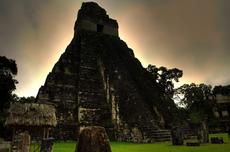Climate of the Mayan era reconstructed in detail
Archaeologists and anthropologists have teamed up with geologists and climatologists to reconstruct the climate that prevailed during the Mayan era using more than 4200 samples from a stalagmite. The detailed reconstruction confirms the suspicion that the development of this advanced civilisation was closely linked to changes in climate, and that periods of extreme drought sealed its decline.

For a long time researchers have been discussing studies linking climate with the development, and especially the collapse, of the Maya between 700 and 1000 AD. One of the criticisms of these studies is that climatologists and archaeologists hardly ever collaborate. However, researchers from the various disciplines have now joined forces and correlated climate data with the historical context. The international research team compared archaeological and anthropological data with detailed geochemical studies carried out by paleoclimatologists from ETH Zurich. The new findings support the theory that climate fluctuations had a decisive influence on Mayan social structures.
Samples taken from the heart of the centres of Mayan civilisation
Sebastian Breitenbach, a speleothem expert from the group led by Gerald Haug, Professor of Climate Geology at ETH Zurich, studied a stalagmite from the Yok Balum cave in Belize, which yielded very high-resolution data – more precisely dated than any other data collected to date – about the climate at that time.
With more than 4200 samples taken from the uppermost 42 centimetres of the stalagmite, the scientists produced a detailed reconstruction of how the climate developed during the Mayan era.
Comparing the climate data with the archaeological data shows that the expansion of the Maya in the lowlands coincides with particularly rainy periods between 450 and approximately 660 AD. During this time agriculture flourished and important centres emerged, such as Tikal in northern Guatemala and Uxbenka in southern Belize.
Wetlands conferred an advantage
Population levels rose and settlements expanded in regions where seasonal wetlands had become established during the wet periods, and near to which the Maya settled. The scientists suspect that heavy rainfall during the early classical Mayan era fed the wetlands, thus filling up the water reservoir on a seasonal basis. That could have given the population centres close to the wetlands a decisive advantage during climatically unreliable periods. “When the climate and social conditions stabilised at the end of the fourth century, the city of Tikal, for example, developed into a dominant socio-political force,” says Sebastian Breitenbach, a postdoctoral student under Haug and one of the main authors of the study. The years up to 650 AD coincide with the emergence of political centres with a wealth of monuments.
However, by using the climate data from the stalagmite, the ETH Zurich researchers were also able to detect evidence of decade-long dry phases as well as short, severe droughts. The trend towards dryness is apparent between 660 and 1000 AD. According to the researchers’ analyses, this initiated a two-stage breakup of the Mayan empire. Between 760 and 800 ADE there are more frequent indications of armed conflicts, the fragmentation of the city states and a destabilised society in the Petexbatun region. Trouble spots continued to spread until around 900 AD and caused a progressive decline in population numbers. According to the new findings, this was followed by a period of severe drought between 1020 and 1100 AD which is said to have brought about the final downfall of the classical Mayan culture.
Highly precise age data
The climate was reconstructed by determining the oxygen isotope ratio between heavy oxygen‑18 and light oxygen-16. Less of the lighter oxygen isotope is incorporated into the stalagmite when conditions are very dry, resulting in a less negative isotope ratio than during wet weather.
The age of the stalagmite used for the climate reconstruction was determined by researchers in the laboratory at the University of New Mexico, based on the radioactive decay of uranium to thorium. This enabled them to reconstruct the age profile of the stalagmite with an inaccuracy of just one to 17 years per dated sample. “This extreme accuracy astonished me,” says Breitenbach. “The ages of the stalagmite samples that were examined are so precise that they put earlier studies in the shade. These older studies, which show much larger age uncertainties, can now hardly be compared directly or correlated with the new ones”.
The age reconstruction showed that the stalagmite grew continuously from 40 BC until the year 2006 – the date when it was “harvested”. Breitenbach confirms that the only time when the stalagmite hardly grew at all was during the period which is being associated with the collapse of the classical Mayan culture. This fits in with the climate data: a shortage of water during prolonged periods of drought causes stalagmites to grow more slowly.
Literature reference
Douglas J. Kennett, Sebastian F. M. Breitenbach et.al: Development and Disintegration of Maya Political Systems in Response to Climate Chang. Published in Science 8 November 2012. DOI: 10.1126/science.1226299







READER COMMENTS